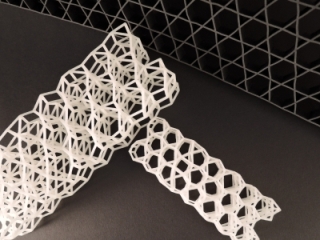Jun 11 2015
A team of scientists from Leiden University has developed a new metamaterial that selectively buckles under different kinds of external stress. The material has small structural variations that pinpoint regions which selectively buckle on demand, while the remaining regions are not affected. The study has been published in the Early Edition of this week's PNAS.

Using metamaterials, it is possible to obtain synthetic structures that have unique characteristics that do not exist in nature. It is possible to program their unusual properties by appropriately designing their topology or geometry.
The research team produced a 3D-printed working model of an innovative metamaterial, which exhibits tunable and selective buckling. The study, headed by Vincenzo Vitelli, was performed in the Topological Mechanics Lab (Leiden). The laboratory is dedicated to exploring the mechanical analogues of topological insulators, newly discovered quantum states of matter. In macroscopic structures, these topological principles result in extraordinary mechanical properties.
"The design begins with a general idea, a physical ‘hunch’, based on this analogy. The major strength of using these topological ideas in metamaterials design is that a topological material is guaranteed to have interesting behaviour at the boundaries," explained Jayson Paulose, co-author of the study.
Next, the reaction of the mechanical analogue with the enforced topological design was predicted, eventually allowing for the development of the material and investigation of what exactly happens during different kinds of external stress. The outcome was a versatile plastic prototype which showed the desired localized buckling response.
"We were expecting some trial and error before getting the design to work. But the first batch that we got back from the 3D printing firm worked right out of the box," said Jayson Paulose.
Materials that buckle selectively under external stress can be used in a variety of potential applications, such as medicine and engineering. It is possible to change the buckling phenomenon without altering other physical characteristics such as heat or electromagnetic conduction.
One application would be in shape-memory materials, wherein shape-transformations occur depending on variations in temperature. In these materials, selective buckling regions will display varied shape transitions from the remaining part of the structure, without any major impact on heat flow. This buckling behaviour gives a novel possibility to adjust such type of devices.
The Delta Institute for Theoretical Physics (Delta ITP) and FOM funded the study.